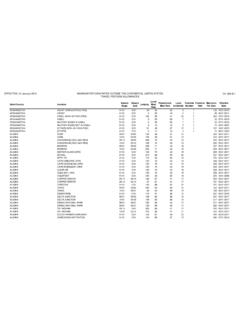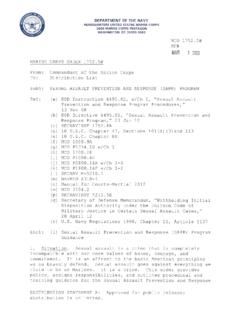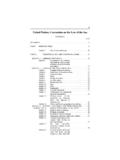Transcription of UNITED STATES TREASURY DEPARTMENT TECHNICAL …
1 UNITED STATES TREASURY DEPARTMENT TECHNICAL EXPLANATIONOF THE CONVENTION BETWEEN THE GOVERNMENT OF THE UNITED STATES OFAMERICA AND THE GOVERNMENT OF AUSTRALIA FOR THE AVOIDANCE OFDOUBLE TAXATION AND THE PREVENTION OF FISCAL EVASIONWITH RESPECT TO TAXES ON INCOMEGENERAL EFFECTIVE DATE UNDER ARTICLE 28: 1 DECEMBER 1983 This Convention, signed at Sydney, Australia on August 6, 1982, was negotiated on thebasis of the Model Convention for the Avoidance of Double Taxation and the Prevention ofFiscal Evasion with Respect to Taxes on Income and Capital, published in May 1977, the Model published in draft form in June 1981 (also referred to as the " Model"), and theModel Double Taxation Convention on Income and Capital published by the Organization forEconomic Cooperation and Development (OECD) in January TECHNICAL explanation is an official guide to the Convention. It reflects policiesbehind particular Convention provisions, as well as understandings reached with respect to theinterpretation and application of the OF ARTICLESA rticle 1---------------------------------Person al ScopeArticle 2---------------------------------Taxes CoveredArticle 3---------------------------------Genera l DefinitionsArticle 4---------------------------------Reside nceArticle 5---------------------------------Perman ent EstablishmentArticle 6---------------------------------Income from Real PropertyArticle 7---------------------------------Busine ss ProfitsArticle 8---------------------------------Shippi ng and Air TransportArticle 9---------------------------------Associ ated EnterprisesArticle 10--------------------------------Divide ndsArticle 11--------------------------------Intere stArticle 12--------------------------------Royalt iesArticle 13--------------------------------Aliena tion of PropertyArticle 14--------------------------------Indepe ndent Personal ServicesArticle 15--------------------------------Depend ent
2 Personal ServicesArticle 16--------------------------------Limita tion on BenefitsArticle 17--------------------------------Entert ainersArticle 18--------------------------------Pensio ns, Annuities, Alimony and Child SupportArticle 19--------------------------------Govern mental RemunerationArticle 20--------------------------------Studen tsArticle 21--------------------------------Income Not Expressly MentionedArticle 22--------------------------------Relief from Double TaxationArticle 23--------------------------------Non-Di scriminationArticle 24--------------------------------Mutual Agreement ProcedureArticle 25--------------------------------Exchan ge of InformationArticle 26--------------------------------Diplom atic and Consular PrivilegesArticle 27--------------------------------Miscel laneousArticle 28--------------------------------Entry into ForceArticle 29--------------------------------Termin ationARTICLE 1 Personal ScopeThis Article identifies the persons who come within the scope of the Convention (alsoreferred to as the Treaty )
3 And establishes the relationship between it and domestic 1 STATES that, except where the Convention specifically provides otherwise, theConvention applies to residents of the UNITED STATES and/or Australia. Certain provisions of theConvention may apply to residents of third counties, for example, paragraph 5 of Article 10(Dividends), paragraph 6 of Article 11 (Interest), and Article 25 (Exchange of Information). Theterm resident is defined in Article 4 (Residence).Paragraph 2 provides that the Convention may not increase tax above the liability thatwould result under domestic law or under other agreements between the Contracting STATES . Ifdomestic law provides a more favorable treatment than the Convention, the taxpayer may applythe provisions of domestic law. For example, if certain interest income derived by nonresidents isexempt from tax by statute, but the Treaty authorizes a tax at source of not more than 10 percent,the statutory exemption will apply. A taxpayer, however, may not make inconsistent choicesbetween the rules of the Internal Revenue Code and the Convention 3 contains the traditional "saving clause" under which each Contracting Statereserved the right to tax its residents, as defined in Article 4 (Residence), as if the Conventionhad not come into effect.
4 The two STATES also reserve the right so to tax their citizens, individualselecting under their respective domestic laws to be taxed as residents, and in the case of theUnited STATES , former citizens whose loss of citizenship had as one of its principal purposes theavoidance of tax. Such former citizens are taxable in accordance with section 877 of the InternalRevenue Code for 10 years following the loss of 4 sets forth certain exceptions to the application of the saving clause whereother provisions of the Convention present overriding policies. The saving clause does notoverride the benefits provided under paragraph 2 of Article 9 (Associated Enterprises), relating tocorrelative adjustments of tax liability, or the benefits of paragraphs 2 or 6 of Article 18(Pensions, Annuities, Alimony and Child Support), relating to social security payments, alimonyand child support. Social security payments and similar public pensions paid by Australia andalimony, child support and similar maintenance payments arising in Australia are taxable only byAustralia even though the recipient may be a resident of the UNITED STATES ; similarly, socialsecurity payments by Australia to a citizen of the UNITED STATES , wherever resident, are taxableonly in Australia.
5 The benefits provided in Articles 22 (Relief from Double Taxation), 23 (Non-Discrimination), and 24 (Mutual Agreement Procedure), and the source rules of paragraph 1 ofArticle 27 (Miscellaneous) are also available to residents and citizens of the Contracting STATES ,notwithstanding the saving some cases, the saving clause overrides benefits otherwise conferred by the UnitedStates on citizens or persons having immigrant status in the UNITED STATES and benefits otherwiseconferred by Australia on citizens or persons ordinarily resident in Australia, but does notoverride those benefits when conferred on other residents of the respective STATES . This secondcategory of exceptions to the saving clause concerns the benefits provided under Article 19(Governmental Remuneration), 20 (Students) and 26 (Diplomatic and Consular Privileges). Theterm immigrant status means a person admitted to the UNITED STATES as a permanent residentunder immigration laws ( , holding a "green card").ARTICLE 2 Taxes CoveredParagraph 1 enumerates the existing taxes to which the Convention applies in eachContracting the UNITED STATES these are the Federal income taxes imposed by the Internal RevenueCode, but excluding the accumulated earnings tax and the personal holding company tax.
6 Socialsecurity taxes and excise taxes, such as those on private foundations and foreign insurers, are notcovered by the Australia the Convention covers the income tax, including the additional tax onundistributed income of private (closely held) 2 provides that taxes enacted after the date of signature of the Convention(August 6, 1982) are also covered if they are substantially similar to the taxes referred to inparagraph 1. The competent authorities agree to notify each other at the end of each calendar yearof substantial changes in their income tax laws or in the official interpretation of those laws or ofthe 3 General DefinitionsParagraph 1 defines some of the principal terms used throughout the Convention. Unlessthe context otherwise requires, the terms defined in this paragraph have a uniform meaningthroughout. A number of other important terms are defined in other Treaty articles. For example,the term "resident" is defined in Article 4 (Residence), the term "permanent establishment" isdefined in Article 5 (Permanent Establishment), and the term "royalties" is defined in Article 12(Royalties).
7 The definitions of the terms "person", "company", "enterprise of a Contracting State", and"international traffic" are similar to the definitions in the "competent authority" for the UNITED STATES is the Secretary of the TREASURY or hisdelegate, and for Australia the Commissioner of Taxation or his authorized definitions of a UNITED STATES corporation and an Australian corporation, respectively,exclude corporations which under the laws of the Contracting STATES are residents of both corporation created and organized under the laws of a state of the UNITED STATES is consideredby the UNITED STATES to be a UNITED STATES corporation. Such a corporation could also beconsidered by Australia to be an Australian corporation if it is managed and controlled inAustralia or if it does business there and its voting power is controlled by Australian residentshareholders. Typically, a corporation can avoid being a dual resident. If such a situation doesarise, the dual resident corporation is not considered a resident of either country for purposes ofthe Treaty and is therefore not entitled to benefits granted by either State under the Treaty toresidents of the other terms " UNITED STATES " and "Australia" are defined to include the continental shelfareas of the two countries with respect to exploration and exploitation of their natural the UNITED STATES , the definition of the continental shelf is interpreted in accordance withsection 638 of the Internal Revenue Code and the regulations thereunder.
8 The term "UnitedStates" does not include Puerto Rico, the Virgin Islands, Guam, or any other UNITED Statespossession. The term "Australia" does include the Territories of Norfolk Island, Christmas Island,the Cocos Islands, Ashmore and Cartier Islands and the Coral Sea Islands; however, see also thediscussion of paragraph 1(a)(iii) of Article 4 (Residence).Definitions are provided for the terms "Contracting State," "State," " UNITED STATES tax,''''Australian tax,'' and resident of one of the Contracting STATES ." The covered taxes do notinclude penalty or interest charges. For example, the ceiling rate of tax at source of 15 percent ondividends under Article 10 (Dividends) does not include any penalty or interest charge for latepayment of 2 provides that terms not defined in the Convention shall have the meaningwhich they have under the laws of the Contracting State concerning the taxes to which theConvention applies, unless the context of the Convention requires a different the terms of Article 24 (Mutual Agreement Procedure), the competent authorities mayagree on a common definition of an otherwise undefined term.
9 The term "context" includes thepurpose and background of the provision in which the term appears. An agreement by thecompetent authorities with respect to the meaning of a term used in the Convention wouldsupersede conflicting meanings in the domestic laws of the Contracting 4 ResidenceThis Article sets forth rules for determining the residence of individuals, corporations,and other persons for purposes of the Convention. A definition of residence is important because,for the most part, only residents of the Contracting STATES may claim benefits under theConvention. The Convention definition is of course, exclusively for purposes of the 1 of this Article describes those persons who, for purposes of the Convention,are residents of Australia or the UNITED (a) provides that a resident of Australia means an Australian corporationand any other person (except a company that is not an Australian corporation) that is resident inAustralia for purposes of its tax. However, if such a person is subject to Australian tax on incomefrom Australian sources (but not on income from sources or other sources outsideAustralia), that person is not a resident of Australia for purposes of this Convention except to theextent that the income is subject to tax in Australia as the income of a resident or is exempt fromAustralian tax solely because it is subject to tax.
10 This provision excludes residents of certainterritories included within the definition of Australia in paragraph 1(k) of Article 3 (GeneralDefinitions) from claiming any Treaty reductions in UNITED STATES tax on UNITED STATES sourceincome under the Treaty; although subject to Australian tax on their Australian source income,such persons are not subject to Australian tax on their UNITED STATES source income and thereason is not solely because they are subject to tax. Similarly, a partnership, estate or trust isa resident of Australia for purposes of the Convention only to the extent that the income itderives is subject to Australian tax as the income of a resident either at the level of thepartnership, estate or trust or in the hands of a partner or beneficiary, or, if that income is exemptfrom Australian tax under the Treaty, it is exempt solely because it is subject to , an Australian trust will be considered a resident of Australia, notwithstanding that itsincome is exempt from Australian tax, if the trust qualifies as a tax exempt organization underAustralian law because it is established for public charitable purposes or scientific , a dividend paid by a corporation to an Australian partnership comprised equally of anAustralian resident partner and an Indonesian resident partner would be treated as paid one halfto an Australian resident and that half would enjoy the reduced rate of tax provided for inArticle 10 (Dividends).
















